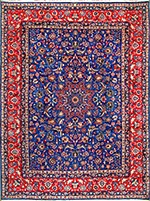Textiles Studies
Date of this Version
4-2000
Document Type
Article
Citation
Journal of Near Eastern Studies, 59:2 (Apr, 2000), pp. 158-159.
Abstract
Islamische Textilkunst des Mittelalters: Aktuelle Problemne. Edited by KAREL OTAVSKY. Riggisberger Berichte 5. Riggisberg, Switzerland: Abegg-Stiftung, 1997. Pp. 219 + 214 figs.
Focusing on textiles of Egypt and North Africa in the Fatimid period (A.D. 909-1171), this volume presents the edited proceedings of a scholarly conference on medieval Islamic textiles held at the Abegg-Stiftung in Riggisberg, Switzerland, 10-11 November 1995. Eighteen papers (published in English, French, or German) by fourteen authors are organized in three sections that deal with the functions, inscriptions, and weaving techniques, followed by a bibliography of references cited, a list of illustrations, and the authors' addresses.
Handsomely produced with high-quality paper and excellent reproductions in black and white, the oversize format of this book affords large-scale images of fragile and fragmentary textiles, permitting their use as visual sources that are otherwise so difficult to see. The focus here is on textiles as primary sources to be considered in conjunction with contemporary and later textual references and with the letters and documents preserved in Cairo's Geniza and elsewhere. A map and an index would have been nice additions. While considerable attention is paid to woven structures and other decorative techniques (embroidery, block-printing, and painting), there is no discussion of looms or dyes. But these are relatively minor omissions; overall, this book is an important contribution to our understanding of the current status of medieval Islamic textile studies. Its intense focus corroborates the signal importance of textiles and public writing in the Fatimid period.
Included in
Art and Materials Conservation Commons, Art Practice Commons, Fiber, Textile, and Weaving Arts Commons, Indigenous Studies Commons, Museum Studies Commons


Comments
Published by The University of Chicago Press.